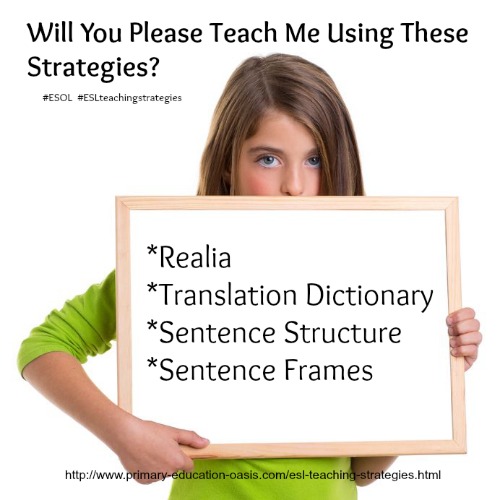These 4 simple ESL teaching strategies (and quick modification tips) will maximize teaching and help you reach all learners.
When a classroom teacher is looking for ESL reading and teaching resources, he or she is searching for a strategy that is easy to implement and highly effective.
Teachers must provide sheltered academic instruction to reach these children. This includes:
- Natural levels of speech that are slowed down to allow students to process what is being said
- Clear enunciation
- Short, simple sentences
- Vocabulary that is tightly controlled
- Visual reinforcement through use of realia
- Ongoing formative comprehension checks
This sounds more complicated than it really is. In fact, many of these strategies are good for all students.
Just a few simple adjustments can make your lessons highly engaging for everyone, but especially ESOL students.
Quick Tips for Modifying Lesson Plans for ESL Learners
The US Department of Education predicts that by 2025,
1:4 public school students will be ESL/ESOL learners.
- Use text that is repetitious
- Pre-teach vocabulary that is important to the lesson
- Use choral reading to support learners
- Shorten passages from the text – only use the most important ideas
- Speak slower, not louder
- Incorporate graphic organizers and other visual aids when possible
- Avoid using descriptive language, such as similes, metaphors and idioms
- Use Big Books with pictures that clearly support the text. Cover specific words and have the students use context to list words that would fit
- Do more background knowledge building
- Focus on “reading the punctuation” so students can hear how our voice changes at the end of sentences
- Use recorded stories frequently (I totally recommend subscribing to RAZ kids as I use this with all of my students)
- Keep in mind the stages of second language acquisition
Four ESL Teaching Strategies
1. Realia
Using realia is one of the most underrated ways for teaching ESL students.
Realia is the use of everyday objects to reinforce learning points, particularly when instructing in Tier 1, 2 and 3 vocabulary.
ESL vocabulary exercises should always include the use of realia as many of our everyday words are confusing for these students. It also allows them to make connections in their own language and culture.
2. Translation Dictionaries
English language learners can connect essential vocabulary and concepts from English to their native language using a printed or electronic translation dictionary.
Be cautious, however, about relying heavily on a translator to make learning connections. If a student selects the wrong definition, the word’s meaning becomes lostor tangled.
Many content specific words are often not found in general translation dictionaries. The student may therefore choose one of the available meanings, and be easily confused.
The translation of focused vocabulary is more effective. Some free online translation resources are:
- Yahoo! Babel Fish can translate words, phrases, blocks of text, or websites from English into about 12 languages.
- Google Language Tools can translate words, phrases, blocks of texts and websites into about 40 – 50 languages. Additionally, it provides a Google interface in about 125 languages, as well as Google sites for 175 countries or other domains.
So what can teachers do?
- Identify essential academic content vocabulary and academic language for English language learners in their classes (such as Supporting English Language Learners in Math Class, Grades K-2).
- Encourage students to translate these important words and phrases into their native languages. Then encourage students to write the translations on any handout that you give them. The result is an annotated learning tool.
3. Clean up Sentence Structure
A variety of sentences makes language more interesting, but it’s not a good idea for English language learners.
When teaching whole class lessons, we have to rephrase or shorten our sentences. Use simpler, clearer words and always check for understanding.
Take the extra effort to rewrite short passages for these students too. They need that support.
Remember that it can take 5 or more years for a student to become proficient in speaking English, let alone writing and reading it!
4. Sentence Frames
A sentence frame is a simplified structure for reading or speaking. Sentence frames use familiar content to probe the use of more complex vocabulary words.
Sentence frames allow for differentiated ESL teaching strategies as well. Speech emergent language learners work on using nouns and verbs. Advanced Fluency learners work on complex comparative sentences.
